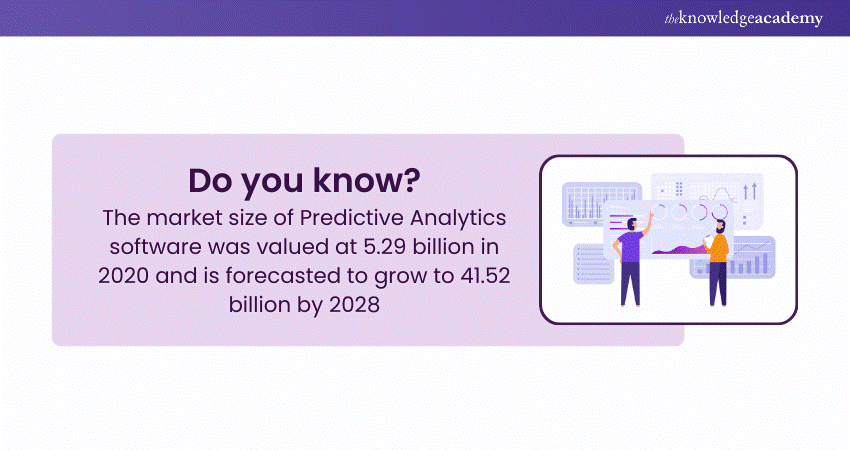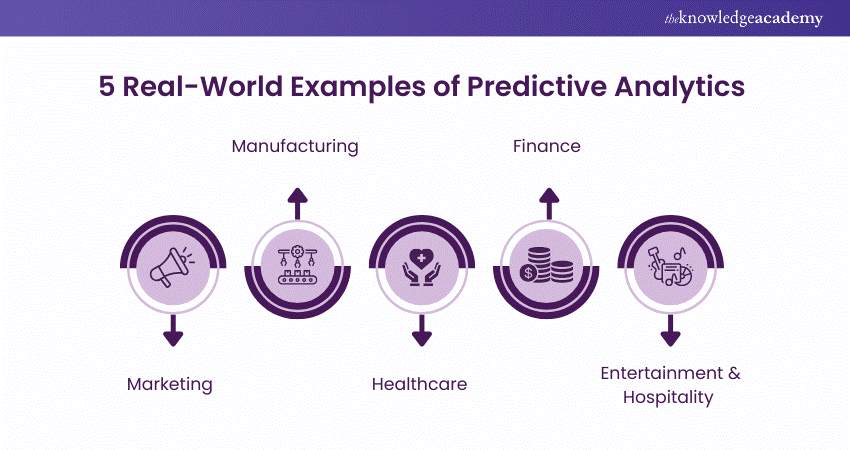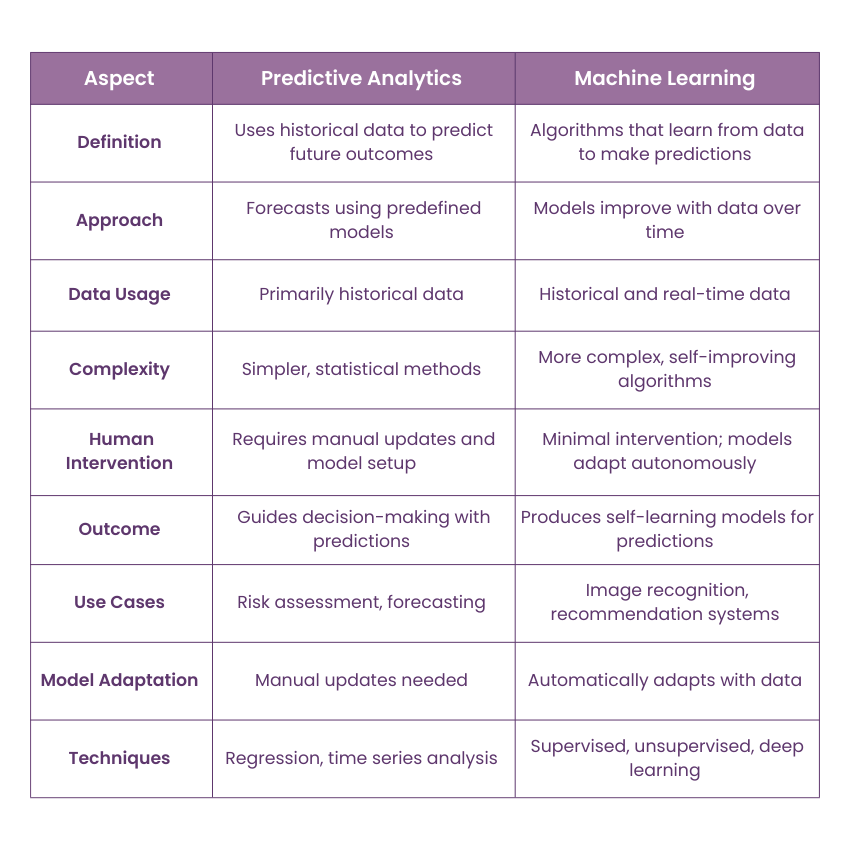We may not have the course you’re looking for. If you enquire or give us a call on 01344203999 and speak to our training experts, we may still be able to help with your training requirements.
We ensure quality, budget-alignment, and timely delivery by our expert instructors.

At any point, did you feel that a brand reads your mind by offering the perfect product just as you were thinking about it? That’s not luck; it’s Predictive Analytics. By turning past behaviour into future insights, it allows businesses to anticipate needs before you even voice them. But what kind of tech can spot trends before they happen? And how are industries using it to stay one step ahead?
From predicting shopping habits to detecting fraud or preventing machine failure, Predictive Analytics is quietly reshaping how decisions are made. In this blog, we’ll explore what these analytics mean, dive into the models that power it, and explore real-world examples that show how it turns data into foresight.
Table of Contents
1) What is Predictive Analytics?
2) How Predictive Analytics Operates?
3) Different Types of Predictive Analytical Models
4) Predictive Analytics Tools
5) Real-world Examples of Predictive Analytics
6) Benefits of Predictive Analytics
7) Difference Between Predictive Analytics and Machine Learning
8) What is the Difference Between Data Analytics and Predictive Analytics?
9) Is Predictive Analysis Same as Forecasting?
10) Conclusion
What is Predictive Analytics?
TPredictive Analytics uses historical data, statistical algorithms, and machine learning techniques to identify future trends and outcomes. It helps businesses make data-driven decisions by analysing patterns and predicting potential risks or opportunities. This approach is widely used in finance, marketing, healthcare, and other industries to enhance efficiency, reduce uncertainties, and improve overall performance.
How Predictive Analytics Operates?
Data Scientists utilise Predictive models to discover relationships between various elements within chosen datasets. After gathering data, a statistical model is created, trained, and adjusted to make predictions.

The workflow for building Predictive Analytics frameworks follows five basic steps:
1) Define the Problem
a) Clarify the Objective: Begin with a clear thesis or hypothesis to guide the analysis.
b) Identify Key Questions: Examples include:
i) Can the model detect fraudulent activity?
ii) What are the optimal inventory levels for peak seasons?
iii) What are the potential flood risks from extreme weather?
c) Select the Appropriate Method: Determine the predictive approach (e.g., classification, regression) based on the problem to be addressed.
2) Acquire and Organise Data
a) Identify Data Sources: Utilise historical records, real-time streams, or both.
b) Assess Data Relevance: Ensure the data aligns with the problem being addressed.
c) Organise Data: Arrange datasets into a storage system, such as BigQuery or other data warehouses, ensuring easy access for analysis.
3) Pre-process Data
a) Clean the Data: Address missing values, inconsistencies, or errors in the dataset.
b) Eliminate Outliers: Remove extreme anomalies caused by measurement or input issues.
c) Standardise and Transform: Format the data consistently, applying necessary transformations (e.g., scaling, normalisation).
4) Develop Predictive Models
a) Select Tools and Techniques: Choose methods such as:
b) Machine Learning (e.g., neural networks, clustering).
c) Regression Models (e.g., linear or logistic regression).
d) Decision Trees (e.g., random forests).
e) Train the Model: Use training datasets to teach the model patterns and relationships.
f) Fine-tune Parameters: Optimise hyperparameters to enhance model performance.
5) Validate and Deploy Results
a) Test Model Accuracy: Validate the model using test datasets to ensure precision.
b) Iterate and Improve: Adjust the model based on validation feedback.
c) Share Results: Present findings through:
d) Interactive dashboards.
e) Integrated apps or websites.
f) Reports tailored to stakeholders' needs.
Different Types of Predictive Analytical Models
Mainly there are five common approaches used in Predictive Analytics: Regression Analysis, Neural Network Models, Clustering Techniques, Time Series Analysis and Decision Tree Models.
1) Regression Analysis
What is Regression Analysis? This model is the most commonly utilised in statistical analysis. Employ it for uncovering patterns in extensive datasets where there exists a linear correlation among the variables. Regression Analysis in Excel simplifies this process, providing easy-to-use tools for running regression models without the need for advanced programming skills.
Decode Complex Data Trends: Elevate Your Skills in Regression Analysis Training Register Now!
2) Neural Network Models
Neural networks were created to minimise the functionality of the human brain for Predictive analysis. This model has the capacity to handle intricate data connections using both artificial intelligence and pattern recognition
3) Clustering Techniques
Clustering involves grouping together data with common characteristics. For instance, Amazon.com can group sales by the number of items bought or by the average length of time customers have had their accounts. By categorising data by common attributes, analysts can discover additional traits that determine upcoming actions.
4) Time Series Analysis
Sometimes, data is linked to time, and certain Predictive Analytics depend on the connection between events and their timing. These models evaluate inputs at various frequencies like daily, weekly, or monthly intervals. Next, analytical models can detect seasonal variations, trends, or patterns in behaviour by analysing timing.
This specific Predictive model aids in forecasting when peak customer service periods or surges in sales can be anticipated.
5) Decision Tree Models
This model categorises data into various segments based on specific factors like price or market capitalisation. It appears similar to a tree with separate branches and leaves, as the name suggests. Branches symbolise the options that are possible, and each individual leaf signifies a specific choice.
Understanding decision trees and breaking them down is straightforward. They come in handy when you require prompt decision-making.
Branch Out Your Skills with Decision Tree Modeling Using R Training for Smarter Insights Register Now!
Predictive Analytics Tools
Predictive Analytics is shaping the future of decision-making, and having the right tools can make all the difference. Whether you're a Data Scientist or a business user, these top eight tools offer powerful capabilities to help you extract insights and forecast trends with confidence.
1) Altair AI Studio
Previously known as RapidMiner Studio, Altair AI Studio is a go-to platform for data mining and Predictive Analytics. It simplifies the process of collecting, cleaning, and modelling data, making it accessible to both data scientists and non-technical users.
With features like Turbo Prep for data preparation and Auto Model for automated machine learning, it helps users build and deploy predictive models with ease. The platform also integrates with generative AI, allowing users to develop large language models and tap into open-source options on Hugging Face.
2) Alteryx AI Platform
Alteryx brings automation to analytics, making it easier to prepare, blend, and analyse data. Its self-service platform includes visual tools for predictive modelling and seamless integration with machine learning frameworks. In 2024, Alteryx expanded its AI capabilities by partnering with Google Cloud's Gemini models, enhancing its ability to deliver advanced insights.
3) Dataiku
Dataiku stands out for its balance between visual and code-based interfaces, catering to both technical and non-technical users. This all-in-one platform streamlines data preparation, machine learning, and predictive modelling, making it easy to generate insights and deploy models without deep coding expertise.
4) H2O Driverless AI
Built on H2O’s open-source machine learning framework, H2O Driverless AI is designed for both Artificial Intelligence (AI) experts and business analysts. It automates key tasks such as feature engineering, model selection, and parameter tuning. The platform also enhances explainability using tools like causal graphs and decision tree surrogates, helping users understand how predictions are made.
5) IBM Watson Studio
IBM has been a leader in Predictive Analytics since acquiring SPSS in 2009. Today, IBM Watson Studio integrates these analytics capabilities into a modern AI-driven environment. Hosted on IBM Cloud Pak for Data, it offers a complete suite of analytics tools, from descriptive to predictive and prescriptive modelling.
Watson Studio is particularly known for making AI-powered decision-making more transparent and collaborative.
6) Microsoft Azure Machine Learning
Microsoft’s Azure Machine Learning seamlessly integrates with Power BI and Excel, making it a natural choice for organiations already using Microsoft’s ecosystem. It supports users at all levels;from business analysts to AI researchers offering tools for the full Predictive Analytics lifecycle.
Features like Azure Data Catalogue, Azure Data Factory, and Azure HDInsight provide powerful data integration and management capabilities, ensuring smooth deployment of Machine Learning models.
Shape curiosity into cutting-edge insights – level up with our Data Science Courses now!
7) SAP Analytics Cloud
Systems, Applications and Products in Data Processing (SAP) has combined Business Intelligence (BI), planning, and Predictive Analytics into a single platform with SAP Analytics Cloud (SAC). Ideal for enterprises using SAP systems, it offers predictive capabilities tailored to logistics, supply chain, and inventory management.
With automation-driven analytics, non-technical users can extract insights effortlessly, while Data Scientists benefit from advanced Machine Learning tools.
8) SAS
One of the pioneers in statistical analytics, SAS has been delivering data-driven insights since the 1960s. Over the years, it has evolved into a leader in Predictive Analytics, offering a vast range of AI and machine learning solutions.
Key products like Statistical Analysis System (SAS) Viya, SAS for Machine Learning, and SAS Intelligent Decisioning help businesses streamline analytics workflows. With strong cloud partnerships, SAS ensures seamless integration with enterprise data ecosystems.
5 Real-world Examples of Predictive Analytics
Here are some of the real-world examples of Predictive Analytics:

1) Marketing
In the field of marketing, a large amount of consumer data is used to develop content, ads, and tactics that can effectively target potential customers in their preferred locations. Engaging in Predictive Analytics involves analysing historical behavioural data to forecast future events.
Forecasting sales trends in marketing using Predictive Analytics can help in planning campaigns for different times of the year.
2) Manufacturing
Within the manufacturing industry, algorithms can be taught using past data to predict with precision when a piece of equipment is expected to break down. If the conditions for a future issue are satisfied, the algorithm will be activated to notify a worker who can halt the equipment and possibly prevent the company from incurring significant product and repair expenses.
This assessment anticipates breakdown situations right now instead of in the distant future.
3) Healthcare
In healthcare, Predictive Analytics involves utilising past data, machine learning algorithms, and statistical techniques to predict future results and patterns.
By examining previous healthcare information, Predictive Analytics helps healthcare professionals predict patient requirements, enhance treatment approaches, and increase efficiency within medical facilities.
4) Finance
All businesses must maintain regular financial records, and Predictive Analytics can significantly impact predicting your company's future well-being. By utilising past financial records and information within the broader industry, you can forecast future sales, revenue, and expenses to create a vision of what lies ahead and accurately make choices.
5) Entertainment & Hospitality
Various factors influence the number of staff members needed at a venue or hotel, which affects customer influx and outflux in entertainment and hospitality. Having too many employees is expensive while having too few can lead to negative customer interactions, exhausted staff, and costly errors.
Convert raw material into professional power- join our Advanced Data Science Certification.
Benefits of Predictive Analytics
Following are the benefits of Predictive Analytics:
1) Enhanced Decision making: Provides data-based insights, enabling businesses to make better-informed decisions.
2) Improved Risk Management: Assists in recognising possible risks and preventing them from happening.
3) Enhanced Efficiency: Improves operations by forecasting demand, inventory requirements, and resource distribution.
4) Enhanced Productivity: Streamlines the examination of Big Datasets, decreasing the time needed for manual analysis.
5) Improved Understanding of Customers: Predicts customer preferences and behaviour to tailor personalised marketing strategies.
6) Cost Savings: Anticipatory analysis minimises wasteful expenses by optimising resource utilisation and concentrating on pertinent opportunities.
Difference Between Predictive Analytics and Machine Learning
Predictive Analytics and machine learning terms are frequently interchanged, as they share similar objectives, yet they differ:
Machine learning tools recognise patterns in data sets and improve prediction accuracy over time, while Predictive Analytics tools utilise Predictive models for more precise event forecasting, like advertisement campaign outcomes.

What is the Difference Between Data Analytics and Predictive Analytics?
Data analytics examines past data to uncover trends, patterns, and insights, while Predictive Analytics goes a step further by using historical data and AI to forecast future outcomes. In short, data analytics helps understand what happened, while Predictive Analytics helps anticipate what will happen next.
Is Predictive Analysis the Same as Forecasting?
Predictive analysis and forecasting are similar but not identical. Forecasting focuses specifically on future trends based on past data, often using statistical models. Predictive analysis, however, is broader—it includes forecasting but also uses machine learning and AI to predict specific events, behaviours, or outcomes with deeper insights.
Conclusion
Predictive Analytics isn't just about crunching numbers; it's about spotting tomorrow's opportunities today. By harnessing the power of data-driven forecasting, businesses can anticipate trends, minimise risks, and make smarter decisions. With the right insights, your data becomes the compass guiding you confidently into the future.
Transform numbers into innovation – get trained by our Python Data Science Training experts!
Frequently Asked Questions
What are the Challenges in Using Predictive Analysis?

Predictive Analysis faces challenges like data quality issues, requiring clean and relevant datasets for accurate results. Model bias, high computational costs, and the need for skilled professionals also pose difficulties. Additionally, integrating predictive models into business workflows and ensuring explainability can be complex.
What is the Objective of Predictive Analysis?

The main goal of Predictive Analysis is to anticipate future trends, behaviours, or risks using historical data, statistical models, and AI. It helps businesses make informed decisions, optimise operations, and reduce uncertainties. Industries use it for customer insights, fraud detection, demand forecasting, and improving overall efficiency.
What are the Other Resources and Offers Provided by The Knowledge Academy?

The Knowledge Academy takes global learning to new heights, offering over 30,000 online courses across 490+ locations in 220 countries. This expansive reach ensures accessibility and convenience for learners worldwide.
Alongside our diverse Online Course Catalogue, encompassing 19 major categories, we go the extra mile by providing a plethora of free educational Online Resources like News updates, Blogs, videos, webinars, and interview questions. Tailoring learning experiences further, professionals can maximise value with customisable Course Bundles of TKA.
What is The Knowledge Pass, and How Does it Work?

The Knowledge Academy’s Knowledge Pass, a prepaid voucher, adds another layer of flexibility, allowing course bookings over a 12-month period. Join us on a journey where education knows no bounds.
What are the Related Courses and Blogs Provided by The Knowledge Academy?

The Knowledge Academy offers various Data Science Courses, including the Predictive Analytics Course and Practitioner Course, and the Advance Data Science Certification. These courses cater to different skill levels, providing comprehensive insights into Data, Analytics & AI.
Our Data, Analytics & AI Blogs cover a range of topics related Data Analytics, offering valuable resources, best practices, and industry insights. Whether you are a beginner or looking to advance your Analytical skills, The Knowledge Academy's diverse courses and informative blogs have got you covered.
Upcoming Data, Analytics & AI Resources Batches & Dates
Date
 Predictive Analytics Course
Predictive Analytics Course
Thu 8th May 2025
Thu 3rd Jul 2025
Thu 4th Sep 2025
Thu 6th Nov 2025






 Top Rated Course
Top Rated Course



 If you wish to make any changes to your course, please
If you wish to make any changes to your course, please


